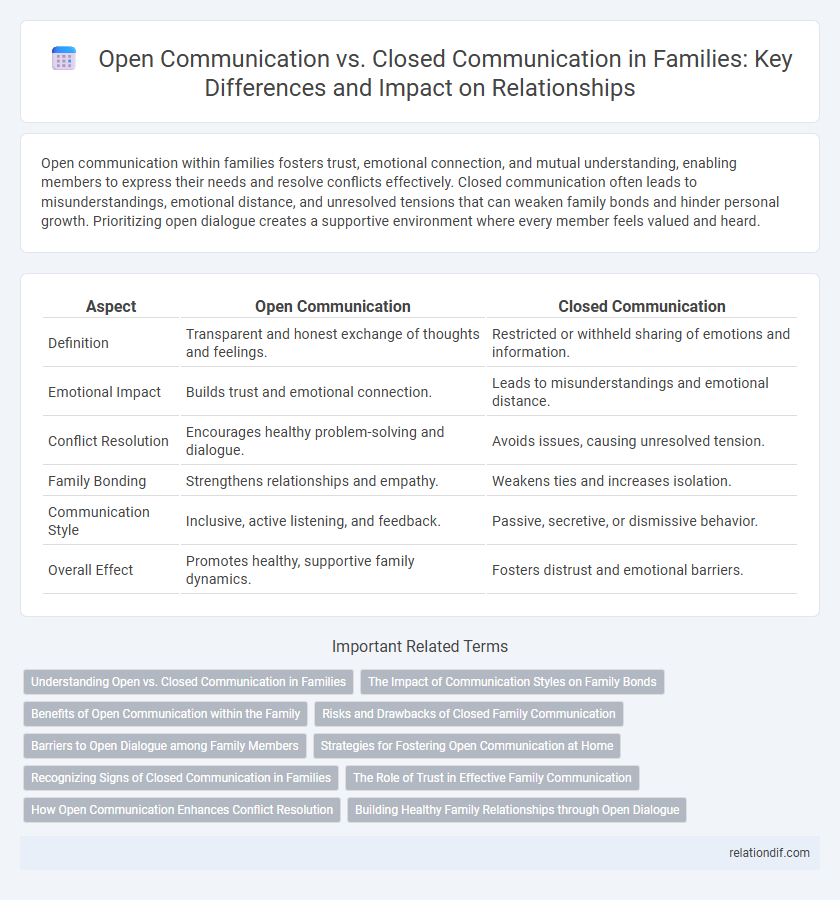Open communication within families fosters trust, emotional connection, and mutual understanding, enabling members to express their needs and resolve conflicts effectively. Closed communication often leads to misunderstandings, emotional distance, and unresolved tensions that can weaken family bonds and hinder personal growth. Prioritizing open dialogue creates a supportive environment where every member feels valued and heard.
Table of Comparison
| Aspect | Open Communication | Closed Communication |
|---|---|---|
| Definition | Transparent and honest exchange of thoughts and feelings. | Restricted or withheld sharing of emotions and information. |
| Emotional Impact | Builds trust and emotional connection. | Leads to misunderstandings and emotional distance. |
| Conflict Resolution | Encourages healthy problem-solving and dialogue. | Avoids issues, causing unresolved tension. |
| Family Bonding | Strengthens relationships and empathy. | Weakens ties and increases isolation. |
| Communication Style | Inclusive, active listening, and feedback. | Passive, secretive, or dismissive behavior. |
| Overall Effect | Promotes healthy, supportive family dynamics. | Fosters distrust and emotional barriers. |
Understanding Open vs. Closed Communication in Families
Open communication in families fosters trust, emotional support, and effective conflict resolution by encouraging honesty and active listening among members. Closed communication often leads to misunderstandings, emotional distance, and unresolved conflicts due to withholding feelings or avoiding difficult topics. Prioritizing open dialogue enhances family cohesion and promotes healthier relationships over time.
The Impact of Communication Styles on Family Bonds
Open communication within families promotes trust, emotional intimacy, and effective conflict resolution, strengthening family bonds over time. In contrast, closed communication often leads to misunderstandings, emotional distance, and unresolved conflicts, weakening relationships and increasing tension. Research shows that families practicing transparent, empathetic dialogue experience higher satisfaction and resilience in their connections.
Benefits of Open Communication within the Family
Open communication within the family fosters trust, emotional support, and stronger relationships by encouraging honesty and understanding among members. It enhances problem-solving skills and reduces conflicts by allowing everyone to express their feelings and perspectives freely. Families practicing open communication experience increased emotional well-being, better conflict resolution, and a more supportive environment for all members.
Risks and Drawbacks of Closed Family Communication
Closed family communication often leads to unresolved conflicts and emotional distress, increasing the risk of misunderstandings and mistrust among family members. Lack of open dialogue can result in suppressed feelings, fostering resentment and weakening family bonds. Such communication barriers may also hinder conflict resolution and emotional support, negatively impacting overall family well-being.
Barriers to Open Dialogue among Family Members
Barriers to open communication among family members often stem from fear of judgment, unresolved conflicts, and emotional distancing, which inhibit honest expression. Cultural norms and generational gaps can also create misunderstandings that discourage sharing true feelings or concerns. Addressing these obstacles requires fostering trust, active listening, and creating a safe environment where each member feels valued and heard.
Strategies for Fostering Open Communication at Home
Encouraging open communication at home involves creating a safe environment where all family members feel heard and respected, fostering trust and emotional connection. Implementing regular family meetings and active listening techniques helps ensure that everyone's perspectives are valued and misunderstandings are minimized. Using positive reinforcement and modeling vulnerability promotes open dialogue and strengthens family bonds.
Recognizing Signs of Closed Communication in Families
Recognizing signs of closed communication in families includes frequent misunderstandings, emotional distance, and avoidance of important topics. Members often withhold feelings or concerns, leading to unresolved conflicts and decreased trust. Persistent silence or one-word answers during conversations signal a breakdown in healthy family dialogue.
The Role of Trust in Effective Family Communication
Trust serves as the foundation for open communication within families, enabling members to share thoughts and feelings without fear of judgment or rejection. When trust is established, family members are more likely to engage in honest dialogues that promote understanding and conflict resolution. In contrast, closed communication often stems from a lack of trust, leading to misunderstandings and emotional distance among family members.
How Open Communication Enhances Conflict Resolution
Open communication fosters trust and transparency within families, allowing members to express feelings and concerns without fear of judgment. This openness helps identify the root causes of conflicts early, facilitating collaborative problem-solving and reducing misunderstandings. Families that practice open communication experience stronger emotional bonds and more effective conflict resolution strategies, leading to healthier relationships.
Building Healthy Family Relationships through Open Dialogue
Open communication fosters trust and understanding among family members, enabling them to express feelings and resolve conflicts effectively. Closed communication often leads to misunderstandings, emotional distance, and unresolved issues that can weaken family bonds. Prioritizing open dialogue creates a supportive environment where all members feel valued, promoting long-term healthy relationships.
open communication vs closed communication Infographic

 relationdif.com
relationdif.com